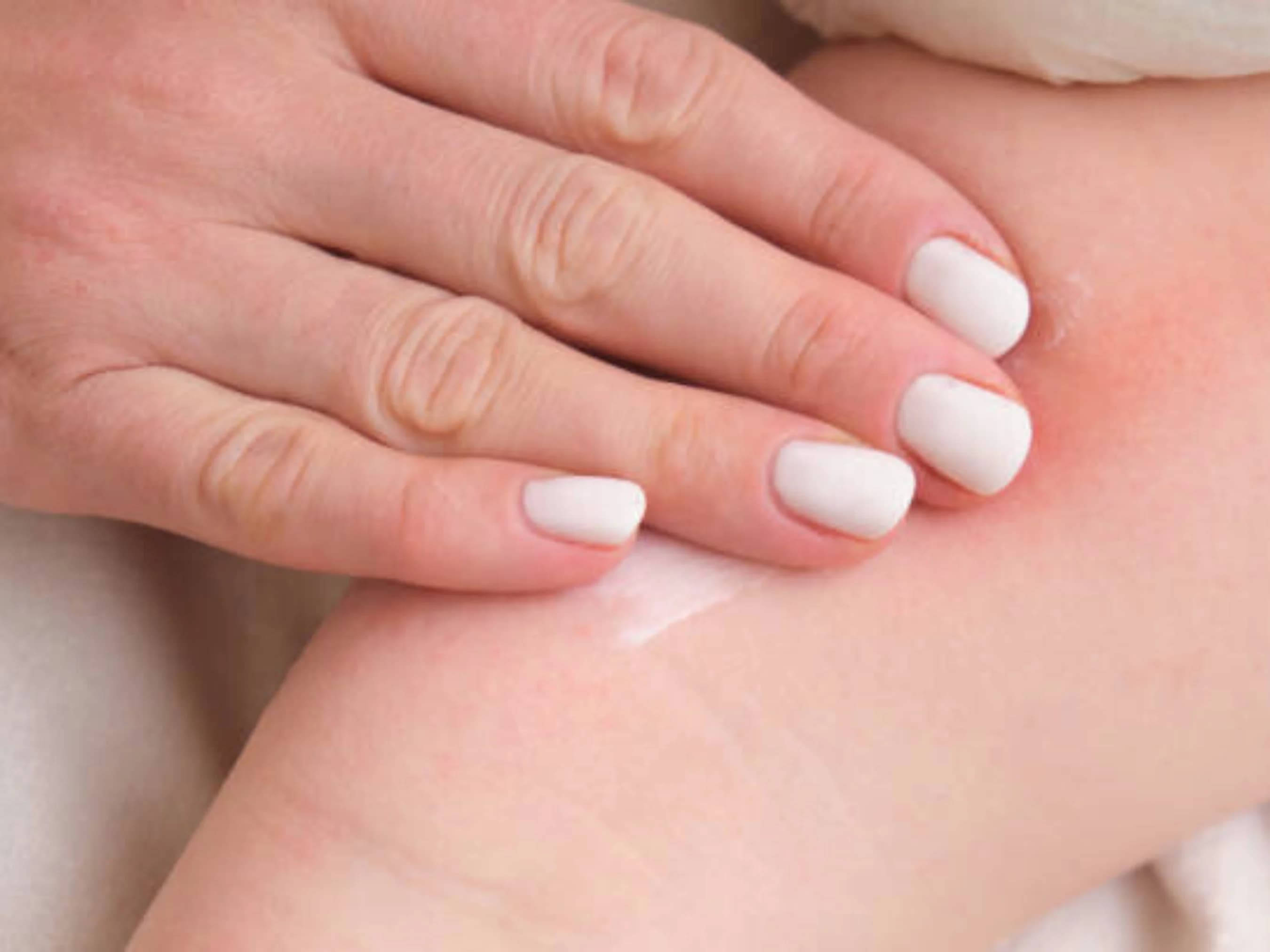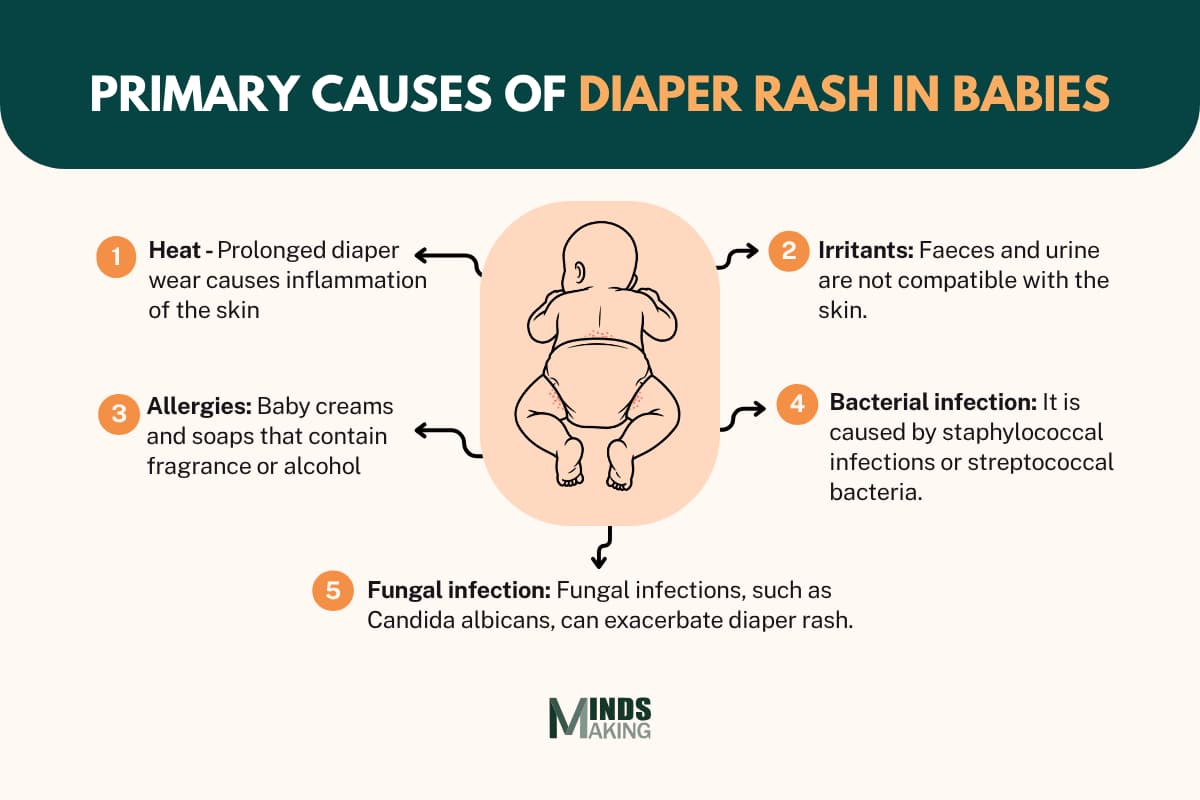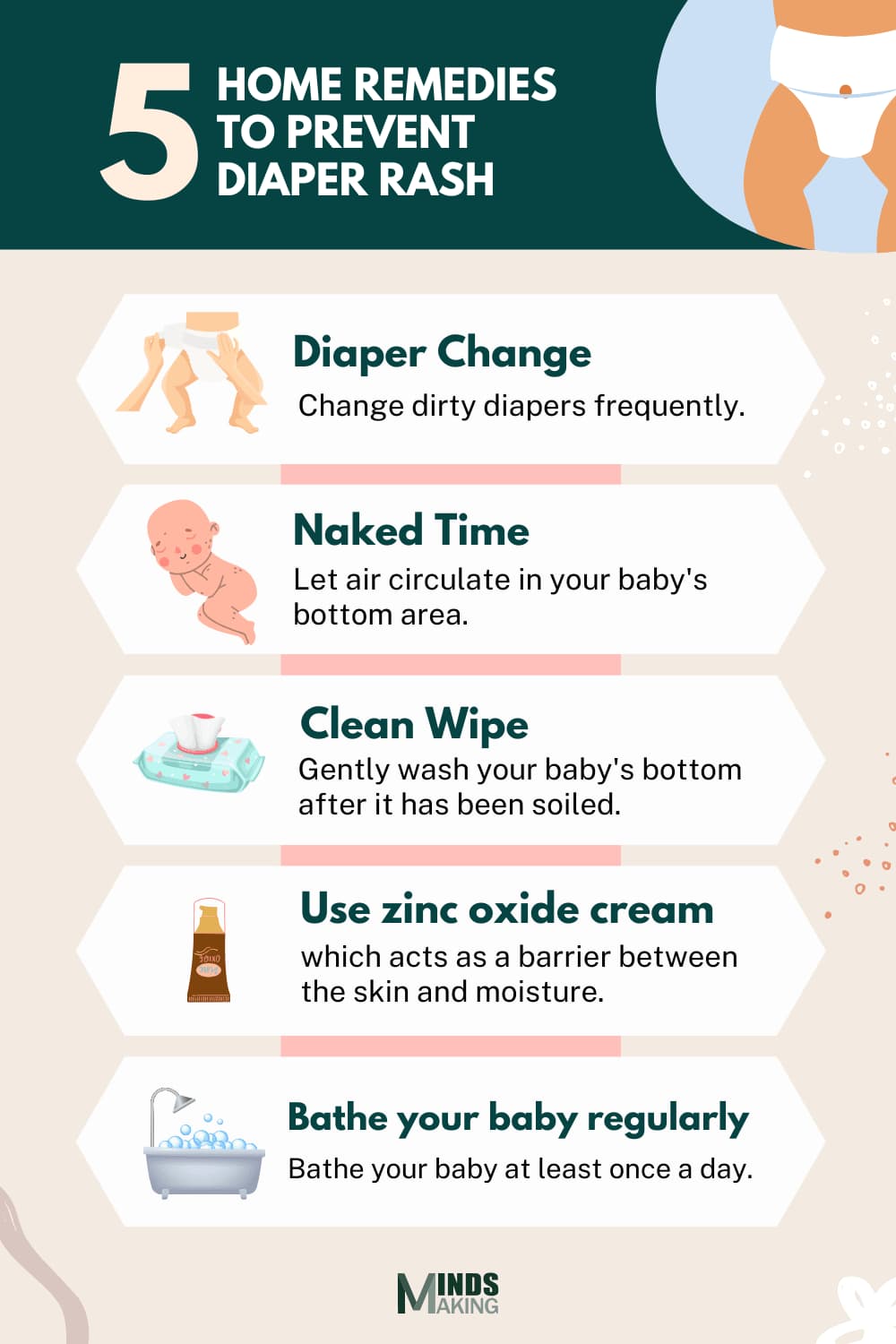Baby Diaper Rash Prevention and Remedies
Getty images

Written by Mindsmaking Medical Writer
Fact Checked by Mindsmaking Professionals
14th, July, 2025
Noticing red, irritated spots on your baby’s bottom? Diaper rash is common, but not all rashes are the same. Learn the causes, types, and best treatment options to soothe your baby’s skin and keep them comfortable.
Diaper rash, also known as diaper dermatitis, is a skin irritation caused by prolonged contact with substances such as feces, urine, and detergents, as well as by moisture and bacterial or candida infections[13]. A study shows it accounts for at least 20% of all pediatric dermatologist visits.[29]
There’s nothing more comforting than your baby’s soft skin, so it’s natural to worry when you notice a rash in their diaper area. Diaper rash is common in babies and toddlers, often linked to irritation from wearing diapers, but it’s usually manageable with the right care.[20]
Even when it's serious, depending on its severity, diaper rash may take several days to resolve completely. However, there are approved treatments that can help you bring much-needed relief to your child.
Key Takeaways
Diaper rash is most commonly caused by prolonged skin contact with moisture, urine, feces, or irritants, and can also result from infections or allergic reactions.
There are different types of diaper rash, including those caused by irritation, yeast infections, bacterial infections, and allergic responses.
A typical diaper rash appears as red, inflamed skin in the diaper area, sometimes with bumps, peeling, or raised patches, depending on the severity and cause.
Common symptoms of diaper rash include redness, swelling, discomfort, fussiness during diaper changes, and in severe cases, blisters or open sores.
To help prevent diaper rash at home, change diapers frequently, gently cleanse the area, allow air-drying, apply barrier creams, and avoid scented wipes or products.
With proper care, most diaper rashes heal within two to three days, but more serious or infected rashes may take longer to clear up.
You should see a doctor if your baby’s diaper rash is severe, doesn’t improve after a few days, worsens, or shows signs of infection such as fever or bleeding.
What does Diaper Rash look like?
Diaper rash may look like patches of an inflamed skin or strings of tiny bumps across the thighs and butt. Commonly found in the area where the diaper sits, the appearance of diaper rash depends on the baby's skin tone [16]. For a lighter skin tone, it is usually red, and for a darker skin tone, it is most likely purplish. Sometimes, it may be represented by small, pus-filled pimples or bumps, surrounded by red patches. Diaper rash could be harmless, itchy, or painful, depending on the cause. It can also be mild or severe.
What Causes Diaper Rash?
Various factors, including heat, friction, and irritants, can cause diaper rash. The prolonged or consistent use of diapers without adequate space for air circulation can cause irritation in the diaper area. A baby's skin is so tender that it's influenced by everything it comes in contact with, even clothes, whether positively or negatively. For diapers, it's no different.
Heat
When a baby wears diapers, air is trapped around the bottom region, limiting circulation and creating a hot environment for the skin in that area. Prolonged diaper wear for a child exposes their skin to a hot, humid environment and retains moisture for an extended period, which can cause skin irritation or inflammation. [3]
Irritants
Along with air and moisture, faeces and urine are among the substances trapped underneath a baby's diaper. Feces and urine don’t mix well with the skin, especially if left unattended for a long time. So if you take your baby out without occasionally checking their diapers for waste products and changing them, the skin under their diapers can get inflamed. [26]
Allergies
While it's not as common as the others, diaper rash can be a direct result of an allergy. For instance, your baby may react to the type of soap or detergent used to wash their nappy area. They may also react to the type or brand of diaper used to wrap their bottom [29]. Baby creams that contain fragrance or alcohol can also be harsh on the skin and cause a rash breakout.
Bacterial infections
The Staphylococcus aureus and the Streptococcus bacteria are examples of bacteria-related contaminants that could cause or worsen diaper rash. A Staphylococcus aureus-infected diaper rash may affect newborns and older toddlers who are still wearing diapers. This type of infection is characterized by large, liquid-filled blisters, also known as impetigo, while strep bacteria-infected diaper rash is characterized by bright red rash breakouts [6].
Fungal Infections
Fungal infections, such as Candida albicans, typically occur when a case of diaper rash has not been properly treated and managed. These infections affect the skin around the genitals and are characterized by bright red patches and blisters, sometimes filled with liquid that may crack and adhere to the skin in that area, resembling dried grease. [28]
Mindsmaking

Types of Diaper Rash
Diaper Rash is not directly linked to a specific demographic of children, as it can affect any baby, regardless of their background. However, the causes can be different. For some babies, it may be hygiene-related issues, and for others, it might be allergies. Depending on the cause, there are different types of diaper rash.
Chafing
This type of diaper rash is caused by friction from constant movement. As babies play, wiggle, or cry, their diapers rub against their waist, buttocks, or upper thighs, leading to skin irritation [21]. This type of diaper dermatitis causes their skin to become red and sometimes bumpy, depending on the level of friction and consistency.
Yeast (Candida) Diaper Rash
If an infection causes diaper dermatitis, it's most often due to a yeast infection. Candidal diaper rash, also known as yeast infection, is caused by the fungus Candida albicans[11]. It mostly occurs when there is an underlying diaper rash that has not been properly treated. If the diaper rash has not been treated properly and the nappy area remains soiled, moist, or wet, the diaper rash may become infected with yeast, leading to more severe symptoms. Yeast rash is characterized by big, bright red patches surrounded by small red spots [5].
Eczema (Atopic Dermatitis)
Eczema, also known as atopic dermatitis, is a very common skin condition that can affect the lower body area of a child. It is characterized by red and discolored dry patches around the genitals, the upper thighs, and in-between the butt cheeks. Atopic dermatitis may be itchy and cause bumps when scratched. Atopic Dermatitis can be triggered by stress, irritants, and allergens, and in some cases, temperature changes [33].
Cradle Cap (Seborrheic Dermatitis)
Cradle Cap, also known as Seborrheic Dermatitis, is characterized by crusty patches on a baby's scalp. However, it can also affect the nappy area, causing white or yellow scales to appear around the area [22]. The area may also appear red, but the rash is not itchy or painful. It is most likely caused by excessive oil (sebum) production, resulting in greasy scales forming in the area [18].
Heat Rash
This type of rash occurs when the diaper area is not well-ventilated. Constant heat and lack of air cause sweat and tiny bumps in the diaper area, especially in the creases. It can also cause redness and itching in the area. Heat rashes are very common in babies and toddlers, especially during the summer.
Impetigo
Impetigo is a highly contagious skin infection that is common in infants and young children [17]. While it often appears on the face, it can also affect the diaper area. It comes in two forms: bullous impetigo, with fluid-filled blisters, and non-bullous impetigo, with pus-filled sores that burst and heal without scarring. [20] [25]
Intertrigo
Intertrigo is a skin irritation caused by skin-to-skin friction, which is often exacerbated by moisture and heat. It commonly affects babies, especially in areas like the thighs or around the genitals, where skin folds rub together and remain humid. It typically begins as redness in the affected area and can worsen if left untreated [12].
Read This Next
No posts available
Home Remedies to Prevent Diaper Rash
Most irritant-based rashes or allergies can be treated at home most of the time without involving a skin specialist. The sooner you start treating the rash, the better your chances are of clearing it up without complications.
- Change your baby's dirty diaper frequently to avoid prolonged contact with trapped moisture, urine, or faeces. [14]
- Avoid using talcum powder and gently pat the nappy area dry with a towel after washing your baby.
- Wash the nappy area gently with a mild, baby-approved soap, or use wipes that are fragrance-free and alcohol-free.
- During diaper change, rub petroleum jelly on your baby's skin to prevent the diaper moisture from touching your baby’s bare skin.
- Use a mild, fragrance-free diaper cream, such as zinc oxide, to act as a barrier between your baby’s skin and the diaper, reducing contact with irritating substances [15].
- Use larger diapers to increase air circulation around your baby's nappy area till the rash goes away.
- Use disposable diapers that are soft and highly absorbent to quickly wick away moisture, reduce skin irritation, and keep your baby dry for longer [6].
- Give your baby some “naked time” out of diapers, which can help speed the healing process. This allows babies to stay dry and avoid friction, allowing their skin to breathe [7].
- Change their diapers at night to keep them dry and comfortable throughout sleep.
- Breast milk contains healing properties that can help soothe and clear up diaper rash when applied to the affected area [30].
Mindsmaking

How Long Does Diaper Rash Last?
The duration of different diaper rash conditions depends on the causes. For mild or common irritant-based conditions, diaper rash typically resolves within 3 to 4 days [8]. Even if it does not completely disappear after four days, it should at least show a significant improvement.
Severe cases like diaper rash caused by bacterial and fungal infections can last for more days, as your baby might need medically-prescribed antibiotics or antifungal treatments.
The life cycle of diaper rash is dependent on multiple factors. There is no consistent length that applies to all types of diaper rash, as several external factors can influence the progression of this skin condition.
Rash severity: The life cycle of any active diaper rash is dependent on its severity. For instance, mild rashes would not stay in the nappy area as long as blisters and bumps. Simple home remedies can resolve the issue, while severe rash cases may require multiple visits to the dermatologist.
Hygiene: Bad hygiene not only exacerbates diaper rash, even in mild cases, but it also contributes to the recurrence of rashes. If your baby is experiencing a mild rash, maintaining good hygiene, such as changing dirty diapers and gently wiping the nappy area, is usually enough to alleviate diaper rash within a few days. Avoid prolonged diaper wear with irritant substances that can cause blisters or bumps, increasing the life cycle of the rash.
Irritants and Diets: Suppose you're still using tight-fitting diapers on your baby. In that case, diaper rash may persist because the diaper continues to rub against your baby's skin, causing friction and ultimately leading to continuous skin irritation, which can prolong the life cycle of the diaper rash or slow recovery. According to Sandra Hong, MD, food intolerance that leads to frequent bowel movements can also cause a baby's buttocks to become sore and red, which can prolong diaper rash if the baby keeps taking the food. [9]
When to see a doctor About Baby Diaper Rash
Diaper rash, especially when caused by irritant-based factors, typically resolves within a few days, provided you maintain consistent hygiene for your baby [32]. However, there are instances where your baby's doctor has the best chance of preventing diaper rash. These instances may include diaper rash caused by bacterial or fungal infections. A doctor can examine your child and prescribe the best possible treatment for severe cases or complications. See a Paediatrician if any of these instances occur:
- If the baby's diaper rash is not showing any sign of improvement even after treatment and hygiene measures.
- If you're dealing with large liquid-filled sores and blisters.
- If little bumps begin to crack and bring out pus.
- If your child is constantly irritated and always crying and tugging at the nappy area[1].
- If your baby's rash persists for more than a week, even if blisters or big bumps are not developing.
- If a high fever accompanies the rash.
Barrier creams prescribed by a dermatologist, such as those containing zinc oxide, may help soothe inflammation in the nappy area and speed up recovery time if applied as directed. These types of cream prevent friction and block moisture from the diaper from reaching the skin. If your doctor thinks a fungal infection causes your baby's diaper rash, they can prescribe an antifungal cream. [24]
Frequently Asked Questions
Is diaper rash contagious?
No, diaper rash is generally not contagious on its own. However, it's caused by a bacterial or fungal infection. Bacterial infections can spread through contact with open sores, while fungal infections can spread when personal items, such as towels, are shared with an infected person.
Can breastfeeding affect diaper rash?
Yes, breastfeeding can escalate diaper rash if a baby is allergic to what the mother eats. Diaper rash can also be influenced if a mother is taking antibiotics and feeding her child.
Can a yeast infection cause diaper rash?
Yes, a yeast infection can cause or exacerbate a diaper rash when the body's balance of yeast is disturbed, or when the required amount of yeast production in the body is disturbing.
Can diet affect diaper rash?
Yes, changes in diet can act as a catalyst for diaper rash, exacerbating the severity. For instance, acidic foods like berries, citrus, and tart foods can irritate sensitive stomachs, potentially increasing the severity of diaper rash.
Can teething cause diaper rash?
Symptoms of teething, like diarrhea, which leads to vomiting and stooling, can induce nappy rash when your child poops continuously. However, teething does not directly cause diaper rash.
How can I treat diaper rash at home?
To treat diaper rash at home, maintain good hygiene for your baby. Bathe them regularly and change their diapers as often as possible. Also, remember to wash up when they're soiled.
Can I use regular lotion instead of diaper rash cream?
It's best to use a medically approved diaper rash cream to help prevent diaper rash in your baby's nappy area. Avoid using creams or ointments your dermatologist did not prescribe.
Is diaper rash a sign of food allergy?
Diaper rash may be a possible sign of food allergy, especially if the child is experiencing stooling or still has recurring diaper rashes despite treatment. Check, it may be due to diet changes.
When should I see a doctor for a diaper rash?
See a doctor if diaper rash symptoms persist and show no sign of improvement, even after trying various treatments. Also, see a doctor if your child is experiencing pain in the lower area or if sores and blisters are present.
Are cloth diapers more effective at preventing diaper rash?
No, cloth diapers are not necessarily better because they can be tight and encourage friction, heat, and direct contact with the baby's skin. Disposable cotton fibers are best.
Can diaper rash be prevented?
Yes, diaper rash can be prevented if you take your baby's hygiene and diaper changes seriously, even if you're busy. Get rid of the soil diapers; it helps your child to be free.
Was this article helpful?
How many stars are you giving this article?
Leave a comment
Your email address will not be published.